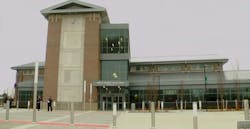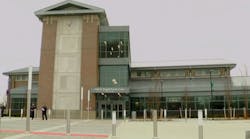Mayor John B. O’Reilly, Jr. celebrated a milestone in a larger vision for passenger rail options at a grand opening ceremony Dec. 15 at the city of Dearborn’s intermodal passenger rail station, dedicated in honor of retiring U.S. Congressman John Dingell, the longest serving member of Congress in U.S. history and an essential advocate for the completion of the transit center.
The city-owned John D. Dingell Transit Center is at 21201 W. Michigan Avenue, west of the Southfield Freeway at the entrance to Dearborn’s west downtown and just north of The Henry Ford. It replaces a smaller station erected by Amtrak on city property in 1979. The station was fully funded by $28.2 million from the federal American Recovery and Reinvestment Act and has free parking, free Wi-Fi, a soon-to-open Tim Hortons restaurant and bike racks.
Amtrak operates and staffs the station. Six daily Wolverine Service trains sponsored by the Michigan Department of Transportation (MDOT) run daily through Dearborn. Nearly 79,000 Amtrak passengers used the former station in the last year, making it the busiest in Metro Detroit, More intercity passenger traffic is expected as MDOT’s accelerated rail project continues between Pontiac and Chicago, via Dearborn.
The station is also an important component in initiatives for commuter rail between Ann Arbor and Detroit. It is also seen as an economic driver for Dearborn and is anticipated to bring more business to the city, and in the future can inspire residential and other developments in the downtown area.
"We are excited not just to open this station, but to be part of the future of rail transportation," said Mayor O’Reilly. "Today marks just the start of the possibilities for economic growth; for greater links between Dearborn, the region and the Midwest; and for our ability to showcase our outstanding community to more visitors, more customers and more employees attracted to our city because of convenient connections."
"We are also pleased to recognize a great public servant, Congressman John Dingell, by naming this Transit Center in his honor. He was always an advocate for this project, and at a real critical juncture facilitated its progress. So its ultimate success is yet another example of how he has worked tirelessly on behalf of our city, our region and our country for nearly 60 years."
Congressman Dingell’s wife, Congresswoman-elect Debbie Dingell, represented her husband during the dedication.
The station is strategically placed so it has easy access to The Henry Ford, the visitor attraction that brings in 1.6 million people each year. Patricia Mooradian, president of The Henry Ford, was among the speakers.
"The Henry Ford is delighted by the formal dedication of the new John D. Dingell Transit Center," said Mooradian. "The center will serve as a major intermodal hub for travelers throughout the region and beyond; a focal point for future transit oriented development here in Dearborn; and a new entryway onto the National Historic Landmark campus of The Henry Ford."
Also during the dedication ceremony, Mayor O’Reilly welcomed dozens of federal, state and local elected officials as well key leaders involved with crafting the future of transit, including Federal Railroad Administrator Joseph Szabo; Tim Hoeffner, director of MDOT’s Office of Rail; and Amtrak Board Member Tom Carper.
State Transportation Director Kirk T. Steudle was unable to attend, but offered his endorsement. "MDOT is proud to have this beautiful station serve passengers on the state-owned rail line," Steudle said. "It is a convenient gateway to the Henry Ford that will be a win-win in helping boost tourism, economic development, and Amtrak ridership."
Amtrak Board Member Carper thanked the community for its progressive transportation and development vision, remembering his service with then-mayor Michael Guido of Dearborn on the Amtrak Mayor’s Council during Carper’s years as the mayor of Macomb, Ill.
"We had outgrown our old Dearborn station," Carper said. "Dearborn led the way with a great new front door, both for Amtrak passengers and for the city’s economic growth as an intermodal transportation hub."
Business leaders also participated in the ceremony, including supportive partners from Ford Motor Co., Ford Land, West Dearborn Downtown Development Authority, East Dearborn Downtown Development Authority, and the Dearborn Area Chamber of Commerce. The University of Michigan-Dearborn was also an advocate of the project.
During the dedication ceremony and an evening open house, the Southeastern Michigan Council of Governments (SEMCOG) displayed a MiTrain railcar, which will be used in the future for commuter traffic, including connections to Detroit Metropolitan Airport. The railcar was remanufactured in Michigan.
The vision for an Intermodal Station
The pedestrian-friendly Dearborn Intermodal Passenger Rail Station serves as a rail gateway to Dearborn and southeast Michigan. The important transportation link will allow thousands of passengers per year to make connections to the Amtrak Wolverine service that extends from Pontiac to Chicago; as well as to SMART, DDOT, Greyhound and charter buses; corporate and hotel shuttles; taxis and personal vehicles.
The station’s proximity to the Rouge River Gateway Trail on the north side of Michigan Avenue in Dearborn should prove popular to pedestrians and bicyclists and provide easy access to the University of Michigan-Dearborn and Henry Ford College.
Also incorporated inside are exhibits by The Henry Ford. Now on display by Ford Motor is the new F-150 truck, of interest because of its aluminum components and its improved energy efficiency.
About the building
The 16,000-square-foot transit center draws on historic railroad architecture, combining traditional red brick with large expanses of glass. As passengers approach, they are greeted by a clock tower with gabled roof. A glass enclosed passenger bridge connects the building with the south platform. The axis of the bridge is aligned with the clock tower of the Henry Ford Museum, an appropriate design move since the station includes a new entrance to the popular cultural institution.
The two-story waiting room includes tall round-arched windows, as well as square windows below the roofline. Altogether, they allow ample natural light to bathe the interior throughout the day. Interior walls are composed of smooth cream colored concrete masonry units accented by rough textured horizontal bands; terrazzo floors are elegant yet durable. Public art includes a mosaic entitled "Transformations" that was designed by Dearborn high school students.
Green elements
Through the selection and use of environmentally friendly materials and design solutions, the John D. Dingell Transit Center achieved a Leadership in Energy and Environmental Design (LEED) Silver certification. Sustainable features include a metal roof with solar collectors, energy-efficient lighting and geothermal heating and cooling.
For more information about the station, its unique features and the rich history of Dearborn with an emphasis on railroads, visit the Amtrak Great American Stations website.
Economic growth
Dearborn is courting further economic possibilities with transit oriented development. Research shows people want to live and work near mixed-use residential and commercial areas close to public transportation and, because they do, property values can be strengthened.



